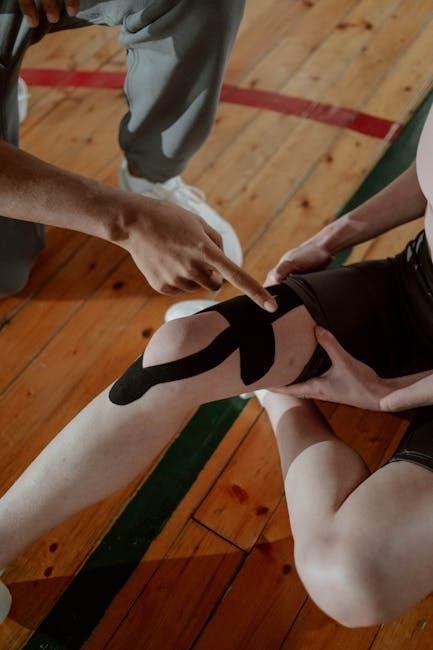A TENS unit is a small, portable medical device that delivers electrical impulses through electrodes placed on the skin to relieve pain․ It is non-invasive, drug-free, and designed for temporary pain relief by blocking pain signals to the brain․ Physicians often prescribe TENS units for at-home use, offering a safe alternative to medication for muscle soreness and discomfort․
1․1 What is a TENS Unit?
A TENS (Transcutaneous Electrical Nerve Stimulation) unit is a portable, battery-powered medical device that delivers low-voltage electrical impulses through electrodes placed on the skin․ It is designed to provide non-invasive, drug-free pain relief by interrupting pain signals to the brain․ Commonly prescribed by physicians for at-home use, TENS units are dual-channel devices that offer multiple modes, including TENS, EMS (Electrical Muscle Stimulation), and Massage․ They are intended for temporary relief of muscle soreness, discomfort, and pain but do not cure the underlying cause․ TENS units are easy to use and offer a safe alternative to pain medications․
1․2 Brief History and Development
The concept of electrical stimulation for pain relief dates back to ancient civilizations, with early forms like torpedo fish used for therapeutic purposes․ Modern TENS units emerged in the mid-20th century, evolving from earlier electrotherapy devices․ The first portable TENS units were developed in the 1970s, revolutionizing pain management by offering a non-invasive, drug-free alternative․ Over time, advancements in technology led to dual-channel devices, programmable settings, and modes like EMS and Massage․ Today, TENS units are widely used for muscle soreness, discomfort, and pain relief, prescribed by physicians and available for at-home use․
1․3 Purpose and Benefits
A TENS unit is primarily designed to provide temporary relief from pain by delivering electrical impulses that interrupt pain signals to the brain․ It is a non-invasive, drug-free solution for managing muscle soreness, discomfort, and pain․ The device is beneficial for conditions like back pain, arthritis, and post-surgery recovery․ TENS units are portable and easy to use, offering multiple modes such as TENS, EMS, and Massage for tailored therapy․ They promote muscle relaxation, improve circulation, and reduce discomfort without the need for medication, making them a popular choice for home use and professional therapy settings․
Key Components of a TENS Unit
A TENS unit includes a control unit, electrodes, lead wires, and a power source․ The control unit regulates intensity and mode, while electrodes deliver electrical impulses to the skin for pain relief․
2․1 Control Unit
The control unit is the brain of the TENS device, housing an 8-bit microcomputer that manages all functions․ It features buttons for adjusting intensity levels, selecting treatment modes, and controlling parameters․ This unit ensures precise delivery of electrical impulses, tailored to individual pain relief needs․ Dual-channel designs allow simultaneous stimulation on multiple body areas․ The control unit is portable, user-friendly, and essential for customizing therapy sessions․ Its advanced technology ensures safe and effective pain management, making it a crucial component for achieving optimal results during treatment․
2․2 Electrodes and Lead Wires
Electrodes are adhesive pads placed on the skin to deliver electrical impulses from the TENS unit․ They are typically pre-gelled for better adhesion and conductivity․ Lead wires connect the electrodes to the control unit, ensuring proper signal transmission․ High-quality electrodes are essential for effective treatment, as poor connectivity can reduce stimulation efficiency․ Regular maintenance, such as cleaning and replacing worn-out electrodes, is recommended to maintain optimal performance․ Proper placement and care of electrodes and lead wires are critical for safe and effective pain relief sessions․
2․3 Power Source
The TENS unit is typically powered by a rechargeable battery, ensuring portability and ease of use․ Some models may also include a USB charging option or a DC adapter for convenient charging․ The battery life varies depending on usage and intensity settings․ Proper charging is essential to maintain the device’s performance, and users should follow the manufacturer’s instructions to avoid overcharging․ A reliable power source is crucial for consistent electrical impulses, making it a key component for effective pain relief sessions․
2․4 Adjustments and Settings
TENS units feature adjustable controls to customize treatment․ Intensity levels can be modified using buttons or dials, starting from low settings and increasing as needed․ Modes such as TENS, EMS, and Massage offer varied stimulation patterns․ Pulse width and frequency are key parameters that can be adjusted to suit individual preferences․ Some devices include preset programs for ease of use․ Users should not exceed recommended intensity levels to ensure safety․ Adjustments allow for personalized pain relief, making the TENS unit versatile for different conditions and user comfort levels․ Proper settings enhance effectiveness and user experience․ Always refer to the manual for specific guidance․
Safety Precautions and Contraindications
TENS units are not suitable for central origin pain or certain medical conditions․ Avoid sensitive areas and use under medical supervision if pregnant or with pacemakers․ Ensure safe application by following guidelines to prevent adverse effects․ Always consult a healthcare professional before use if unsure․
3․1 Who Should Not Use a TENS Unit
Individuals with certain medical conditions should avoid using a TENS unit․ This includes those with pacemakers, as the electrical impulses may interfere with the device․ Pregnant women, especially in early pregnancy, should consult their doctor before use․ People with epilepsy or those prone to seizures should avoid TENS therapy․ Additionally, individuals with open wounds, skin infections, or sensitive areas should not apply electrodes․ Central origin pain, such as headaches, does not respond well to TENS․ Always seek medical advice if unsure about safe usage․
3․2 Safety Guidelines for Use
Always read the instruction manual carefully before using a TENS unit․ Ensure the device is used only for its intended purpose and avoid operation near water․ Do not use a TENS unit with other TENS devices simultaneously․ Electrodes should be placed on healthy, intact skin, avoiding sensitive areas․ Start with low intensity and gradually increase as needed․ Consult a healthcare provider if you have underlying medical conditions․ Never use the device while charging․ Turn off the unit when not in use, and avoid sharing the device with others to maintain hygiene and safety․
3․3 Contraindications
TENS units are not suitable for everyone․ Contraindications include pregnancy, as the effects on the fetus are unknown․ They should not be used over open wounds or on sensitive areas like the face or neck․ Individuals with pacemakers or other implanted medical devices should avoid using TENS units due to potential interference․ Additionally, TENS units are ineffective for pain of central origin, such as headaches, and should not be used as a substitute for prescribed pain medications or treatments․ Always consult a healthcare provider before use if unsure․
Setting Up the TENS Unit
Unpack the device, ensuring all components are included․ Charge the unit as per instructions, then connect the electrodes to the control unit properly before use․
4․1 Unpacking and Inventory
When you receive your TENS unit, carefully unpack the device and verify all components are included․ Typically, the package contains the control unit, electrodes, lead wires, a power source (batteries or charger), and a user manual․ Check for any visible damage or missing items․ Ensure the electrodes and wires are intact and free from defects․ If any components are damaged or missing, contact the supplier immediately․ Familiarize yourself with the contents before proceeding to charging and setup․ Proper inventory ensures smooth operation and safety during use․
4․2 Charging the Device
Before using your TENS unit, ensure the device is fully charged․ Connect the USB charger to the control unit and plug it into a power source․ The charging time varies by model but typically takes 2-4 hours for a full charge․ A battery indicator on the device will show charging progress․ Avoid overcharging, as it may reduce battery life․ Once charged, disconnect the charger and store it properly․ Always refer to the user manual for specific charging instructions, as procedures may vary depending on the model․ Proper charging ensures optimal performance and longevity of the unit․
4․3 Connecting Electrodes
To connect the electrodes, first ensure they are properly attached to the lead wires․ Align the electrode pads with the designated ports on the control unit and secure them firmly․ Place the electrodes on clean, dry skin, positioning them over the targeted pain area․ Ensure the pads are pressed securely to maintain proper contact․ If additional stability is needed, use the provided straps or adhesive sleeves․ Double-check the connections to confirm the electrodes are properly linked to the device․ Once connected, turn on the unit and test the stimulation to ensure it is functioning correctly․ Proper electrode connection is essential for effective therapy․

Operating the TENS Unit
Turn the device on using the power button․ Adjust intensity levels gradually for comfort․ Select the desired treatment mode and monitor stimulation․ Ensure settings align with your pain relief needs․
5․1 Turning the Device On/Off
To turn the TENS unit on, locate the power button, typically found on the control panel․ Press and hold the button until the device activates․ Ensure the unit is fully charged or has fresh batteries․ When turning off, press the power button again until the device shuts down․ Always refer to the manual for specific instructions, as designs may vary․ Properly turning the device on/off ensures optimal performance and preserves battery life․ Follow these steps carefully to maintain functionality and safety during use․
5;2 Adjusting Intensity Levels
Adjusting the intensity levels on a TENS unit ensures a comfortable and effective treatment experience․ Start with the lowest setting and gradually increase using the intensity adjustment buttons․ Press the “+” button to raise the intensity and the “-” button to lower it․ Continue until you feel a mild tingling or buzzing sensation․ Avoid setting the intensity too high, as it may cause discomfort․ Adjustments can be made during a session if needed․ Always refer to the user manual for specific instructions, as controls may vary between models․ Proper intensity adjustment ensures optimal pain relief without discomfort․
5․3 Navigating Treatment Modes
TENS units offer multiple treatment modes to customize your pain relief experience․ Common modes include TENS, EMS, and Massage․ Use the mode button to cycle through options․ TENS mode delivers a constant or pulsating current for pain relief․ EMS mode provides muscle stimulation for strength and recovery․ Massage mode mimics the sensation of a massage for relaxation․ Start with the mode that best suits your needs․ Adjust intensity levels within each mode for comfort․ Refer to your manual for specific mode descriptions and settings․ Experiment with different modes to find what works best for your condition․ This ensures an effective and personalized treatment session․

Understanding Treatment Modes
TENS units feature multiple treatment modes to target pain relief, muscle stimulation, and relaxation․ Each mode delivers unique electrical impulses to address specific needs effectively․
6․1 TENS Mode
TENS (Transcutaneous Electrical Nerve Stimulation) mode is designed to relieve pain by blocking pain signals to the brain․ It works by delivering low-voltage electrical impulses through electrodes placed on the skin․ This non-invasive, drug-free method is ideal for managing chronic or acute pain․ TENS mode is typically used for pain relief in areas like the back, shoulders, or legs․ Users can adjust the intensity to a comfortable level, ensuring effective pain management without discomfort․ Always follow the instruction manual for proper settings and electrode placement to maximize results and safety․
6․2 EMS Mode
EMS (Electronic Muscle Stimulation) mode focuses on muscle rehabilitation and strength enhancement․ It generates electrical impulses that simulate muscle contractions, improving circulation and reducing muscle soreness․ Unlike TENS, EMS is not primarily for pain relief but targets muscle recovery and relaxation․ It is commonly used post-workout or for muscle stiffness․ Users can adjust settings to customize the intensity of muscle stimulation․ EMS mode is effective for enhancing muscle tone and aiding in recovery, making it a popular choice for athletes and individuals with muscle-related discomfort․ Always refer to the manual for specific usage guidelines and safety precautions․
6․3 Massage Mode
Massage Mode mimics the sensation of a gentle massage, providing relaxation and muscle relief․ It uses rhythmic, pulsing electrical impulses to soothe tense muscles, improve circulation, and reduce stiffness․ Unlike TENS and EMS modes, Massage Mode focuses on comfort rather than pain relief or muscle strengthening․ It is ideal for unwinding after physical activity or for general relaxation․ Users can adjust the intensity to suit their comfort level, making it a versatile option for daily use․ This mode is particularly popular for its calming effects and ability to enhance overall muscle well-being without intense stimulation․

Placing the Electrodes
Proper electrode placement is crucial for effective pain relief․ Identify the pain area, then place electrodes on clean, dry skin near the source of discomfort․ Avoid sensitive areas like the face or neck․ Ensure electrodes are securely attached for consistent stimulation․ Always follow the manufacturer’s guidelines for optimal placement and safety․
- Identify the pain area accurately․
- Place electrodes on clean, dry skin․
- Avoid sensitive or restricted zones․
7․1 Identifying Pain Areas
Accurately identifying pain areas is essential for effective TENS therapy․ Locate the source of discomfort by palpation or visual inspection; Common areas include the lower back, shoulders, or joints․ For localized pain, place electrodes near the affected region․ Avoid central origin pain, such as headaches, as TENS is ineffective for these․ Ensure the area is clean and dry before electrode placement․ Targeting the correct area enhances stimulation efficiency and pain relief outcomes․ Always refer to the manual for specific guidance on identifying suitable treatment zones․
- Locate pain through palpation or inspection․
- Focus on areas like lower back or joints․
- Avoid central origin pain, such as headaches․
7․2 Proper Placement Techniques
Proper electrode placement is crucial for effective pain relief․ Place electrodes directly over or around the painful area, ensuring they are symmetrically positioned․ Avoid placing electrodes over joints, sensitive areas, or broken skin․ Clean and dry the skin before applying electrodes to ensure proper adhesion and conductivity․ For optimal results, follow the manufacturer’s guidelines for specific conditions․ Always avoid crossing electrodes or placing them on the same nerve pathway․ Correct placement enhances stimulation efficiency and ensures targeted pain relief․ Consult the manual for detailed diagrams or instructions specific to your unit․
- Place electrodes symmetrically over the pain area․
- Avoid joints, sensitive areas, or broken skin․
- Ensure skin is clean and dry for proper adhesion․
7․3 Avoiding Sensitive Areas
When placing electrodes, it is essential to avoid sensitive areas to prevent discomfort or complications․ Do not place electrodes near the eyes, mouth, or over open wounds․ Avoid areas with fragile skin, such as the neck near the carotid sinus, or over the head․ Pregnant women should not use electrodes over the uterus․ Additionally, avoid placing electrodes on areas with implanted medical devices, such as pacemakers, as this may interfere with their function․ Always follow the manufacturer’s guidelines to ensure safe and effective use․
- Avoid placing electrodes near the eyes or mouth․
- Do not use electrodes on the neck or carotid sinus area․
- Refrain from placing electrodes over the head or uterus during pregnancy․
- Avoid areas with broken skin or implanted medical devices․
Using the TENS Unit for Pain Relief
A TENS unit provides temporary relief for sore muscles and discomfort by delivering electrical impulses, targeting pain areas effectively with adjustable intensity and multiple treatment modes․
8․1 Step-by-Step Usage Guide
- Unpack and charge the TENS unit according to the manual․
- Connect the electrodes to the control unit and place them on the skin near the pain area․
- Turn on the device and start with the lowest intensity setting․
- Gradually increase the intensity until a comfortable tingling sensation is felt․
- Select the appropriate treatment mode (TENS, EMS, or Massage)․
- Use the device for the recommended duration (typically 20-60 minutes)․
- After the session, turn off the device and remove the electrodes․
- Clean and store the unit and electrodes properly for future use․
Always follow the manufacturer’s guidelines and consult a healthcare professional if needed․
8․2 Recommended Treatment Duration
The recommended treatment duration with a TENS unit typically ranges from 20 to 60 minutes per session․ For acute pain, shorter sessions (20-30 minutes) may suffice, while chronic pain may require longer durations․ It is advised to use the device 2-3 times daily, allowing breaks between sessions to avoid skin irritation․ Start with shorter sessions and gradually increase as needed․ Exceeding the recommended time does not enhance pain relief and may cause discomfort․ Always follow the manufacturer’s guidelines and consult a healthcare professional for personalized advice․
8․3 Frequency of Sessions
The frequency of TENS unit sessions depends on the type and severity of pain․ For most users, sessions can be conducted 2-3 times daily, with at least 30-60 minutes of rest between treatments․ This prevents skin irritation and ensures optimal effectiveness․ Chronic pain may require more frequent use, while acute pain may need less․ Always adhere to the manufacturer’s guidelines and consult a healthcare professional for personalized recommendations․ Overuse can lead to reduced efficacy or discomfort, so balancing session frequency is crucial for long-term benefits;

Maintenance and Care
Regularly clean the device with a damp cloth and store it in a dry, cool place; Replace electrodes as needed and check for worn-out parts to ensure optimal performance․
9․1 Cleaning the Device
Regular cleaning of the TENS unit is essential for maintaining its performance and longevity․ Use a soft, damp cloth to wipe the control unit, avoiding harsh chemicals or submerging it in water․ For electrodes, gently clean them with mild soap and water, ensuring no residue remains․ Allow all components to air dry completely before storage or use․ Avoid using abrasive materials that could damage the surfaces․ Proper cleaning ensures optimal conductivity and prevents bacterial growth, guaranteeing safe and effective treatment sessions․
9․2 Storing the Unit
Store the TENS unit in its original packaging or a protective case to prevent damage․ Keep it in a cool, dry place, away from direct sunlight and moisture․ Ensure the device is turned off and all cables are securely stored to avoid tangling․ Avoid extreme temperatures or humidity, as this may damage the electronics․ Regularly check the unit for dust or debris and clean it before storage․ Proper storage maintains the device’s functionality and ensures it remains ready for future use, preserving its longevity and performance․
9․4 Replacing Electrodes
To replace electrodes, start by turning off the TENS unit and disconnecting the lead wires․ Remove the old electrodes carefully and dispose of them properly․ Take new electrodes from their packaging, ensuring they are free of protective coverings․ Attach them to the lead wires, securing them firmly for proper conductivity․ Finally, test the unit at a low intensity to ensure the new electrodes are functioning correctly․ Regular replacement maintains optimal performance and adhesive quality, ensuring effective pain relief during use․
Troubleshooting Common Issues
Address common issues like device malfunction or weak stimulation by checking connections, power sources, and intensity settings․ Refer to the troubleshooting section for detailed solutions․
10․1 Device Not Turning On
If the TENS unit fails to turn on, first check the power source․ Ensure the battery is fully charged or replace it if necessary․ Verify that the USB connector is securely plugged in during charging․ Next, inspect the electrodes and lead wires for proper connection to the control unit․ Weak or damaged connections may prevent the device from activating․ Also, ensure the intensity settings are not set to zero, as this can prevent stimulation․ If issues persist, refer to the user manual or contact customer support for further assistance․
10․2 Weak or No Stimulation
If the TENS unit provides weak or no stimulation, check the electrode placement and ensure they are securely attached to the skin․ Verify that the intensity level is set above zero and gradually increase it until a comfortable sensation is felt․ Inspect the lead wires and connections for damage or looseness․ Ensure the device is fully charged or replace the battery if necessary․ If issues persist, try replacing the electrodes with new ones․ Consult the user manual for troubleshooting steps or contact customer support for further assistance to resolve the problem effectively․
10․3 Error Codes
Error codes on a TENS unit indicate specific issues that need attention․ Common codes like “E1” or “E2” often relate to electrode or connection problems․ If an error code appears, refer to the user manual for its meaning․ Ensure electrodes are properly connected and placed․ Restart the device or check for blockages in the wires․ If the issue persists, reset the unit or contact customer support for assistance․ Error codes are designed to help troubleshoot and restore functionality quickly, ensuring effective pain relief without interruptions․ Always follow the manual’s guidance for resolving errors․

FAQs About TENS Units
FAQs about TENS units address common queries, such as usage, safety, and effectiveness․ Users often ask if TENS units are suitable for all body parts or safe for long-term use․ Consulting the manual ensures clarity on these topics and provides guidance for optimal results․
11․1 Can TENS Units Be Used on All Body Parts?
TENS units are effective for relieving pain in specific areas like muscles in the shoulder, waist, and back․ However, they are not suitable for central origin pain, such as headaches․ Avoid placing electrodes on sensitive areas or near the heart․ Users should consult the manual or a healthcare professional to ensure proper and safe usage, as certain body parts or conditions may not be appropriate for TENS therapy․
11․2 Are TENS Units Safe for Long-Term Use?
TENS units are generally safe for long-term use when operated correctly․ They provide non-invasive, drug-free pain relief without serious side effects․ However, long-term use should adhere to the manufacturer’s guidelines and medical advice․ Users should avoid relying solely on TENS units for chronic pain without addressing the underlying cause․ Proper usage and regular monitoring ensure safety and effectiveness over extended periods․ Consulting a healthcare professional is recommended for prolonged or chronic pain management․
11․3 Can I Use a TENS Unit During Pregnancy?
Using a TENS unit during pregnancy is generally not recommended without medical supervision․ While TENS is non-invasive, there is limited research on its safety for pregnant individuals․ It should not be used near the abdominal or pelvic area, as it may stimulate uterine contractions․ Always consult a healthcare provider before using a TENS unit during pregnancy to ensure it is safe and appropriate for your specific situation․
A TENS unit is a portable, effective tool for pain relief․ Always follow the instruction manual and consult a healthcare provider for safe, optimal use․
12․1 Summary of Key Points
A TENS unit is a portable, non-invasive device that delivers electrical impulses through electrodes to relieve pain․ It is drug-free and designed for temporary relief by blocking pain signals to the brain․ Physicians often prescribe TENS units for at-home use, offering a safe alternative to medication for muscle soreness and discomfort․ The device operates in modes like TENS, EMS, and massage, providing customizable treatment․ Always follow the instruction manual and consult a healthcare provider for safe, optimal use․ Proper placement of electrodes and adherence to safety guidelines are essential for effectiveness․
12․2 Final Tips for Effective Use
For optimal results, always read the instruction manual thoroughly before using your TENS unit․ Ensure electrodes are placed correctly on clean, dry skin for maximum conductivity․ Start with low intensity and gradually increase as needed for comfort․ Choose the appropriate mode (TENS, EMS, or massage) based on your pain type․ Regularly clean and store the device properly to maintain its performance․ Consult a healthcare provider for personalized advice, especially for chronic conditions․ Combine TENS therapy with other pain-relief methods for enhanced effectiveness․ Always follow safety guidelines to avoid adverse effects․



